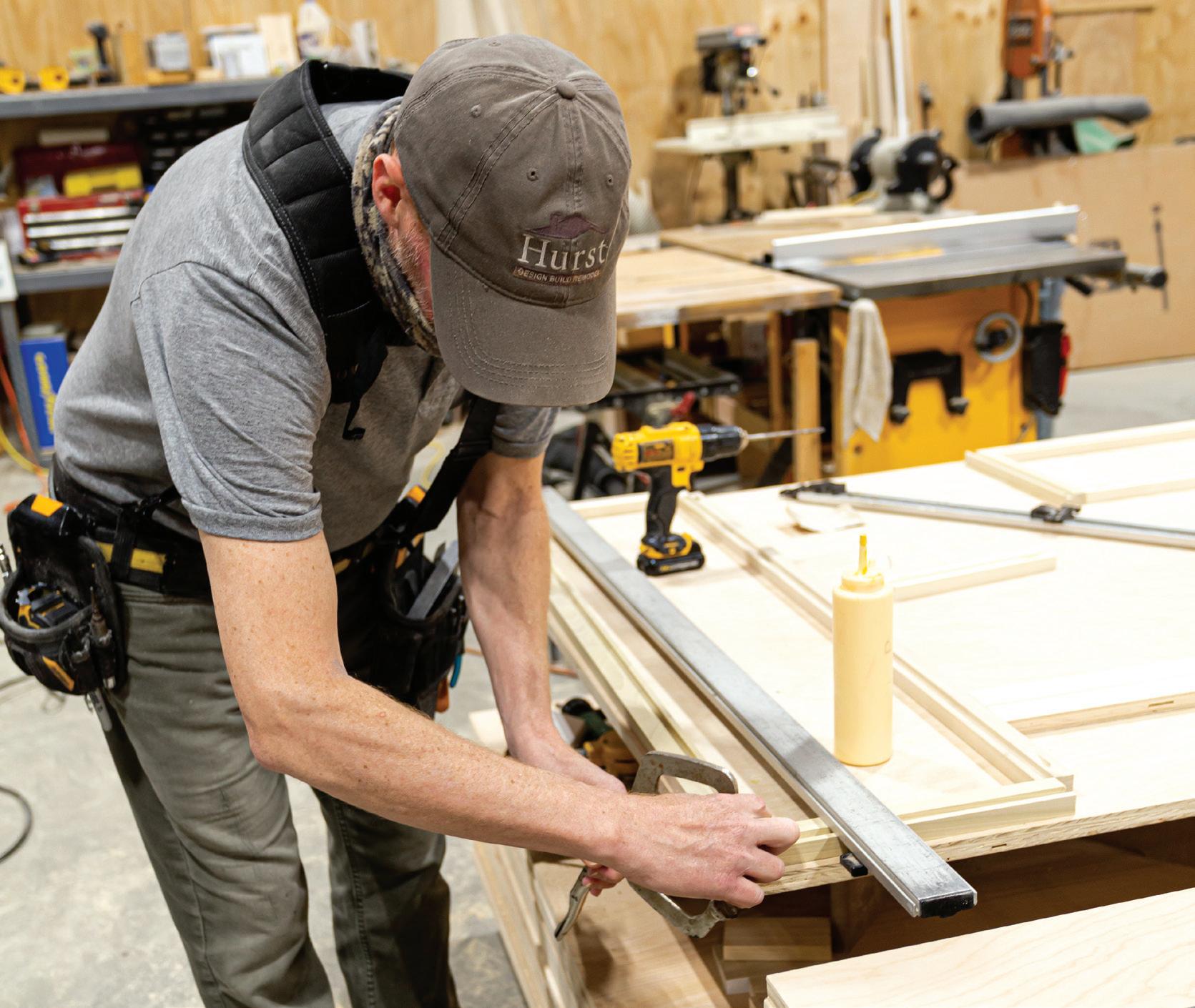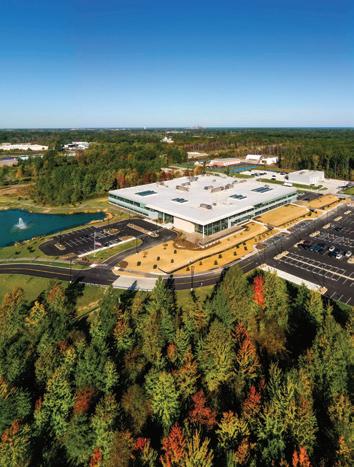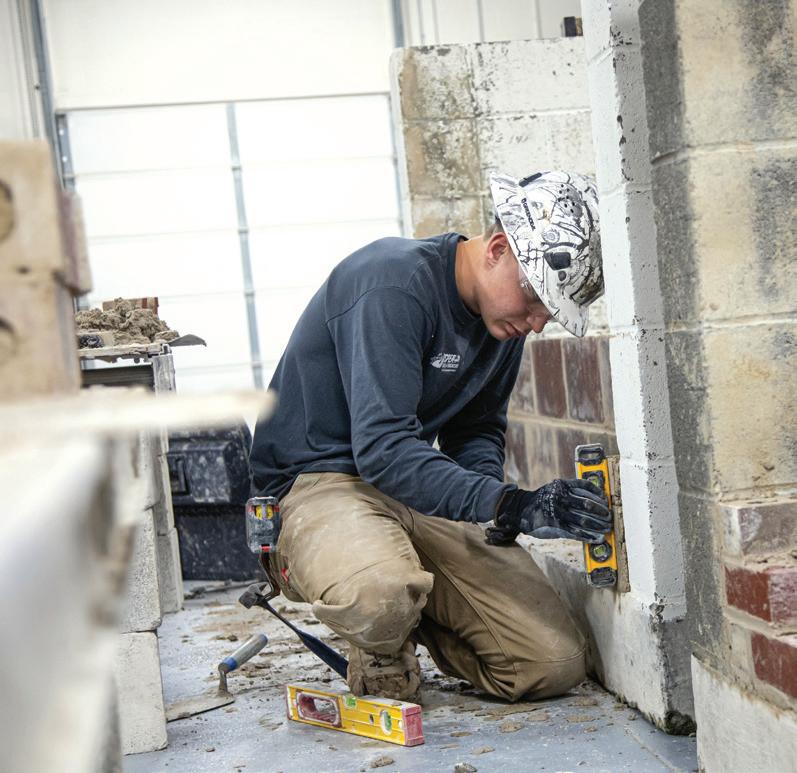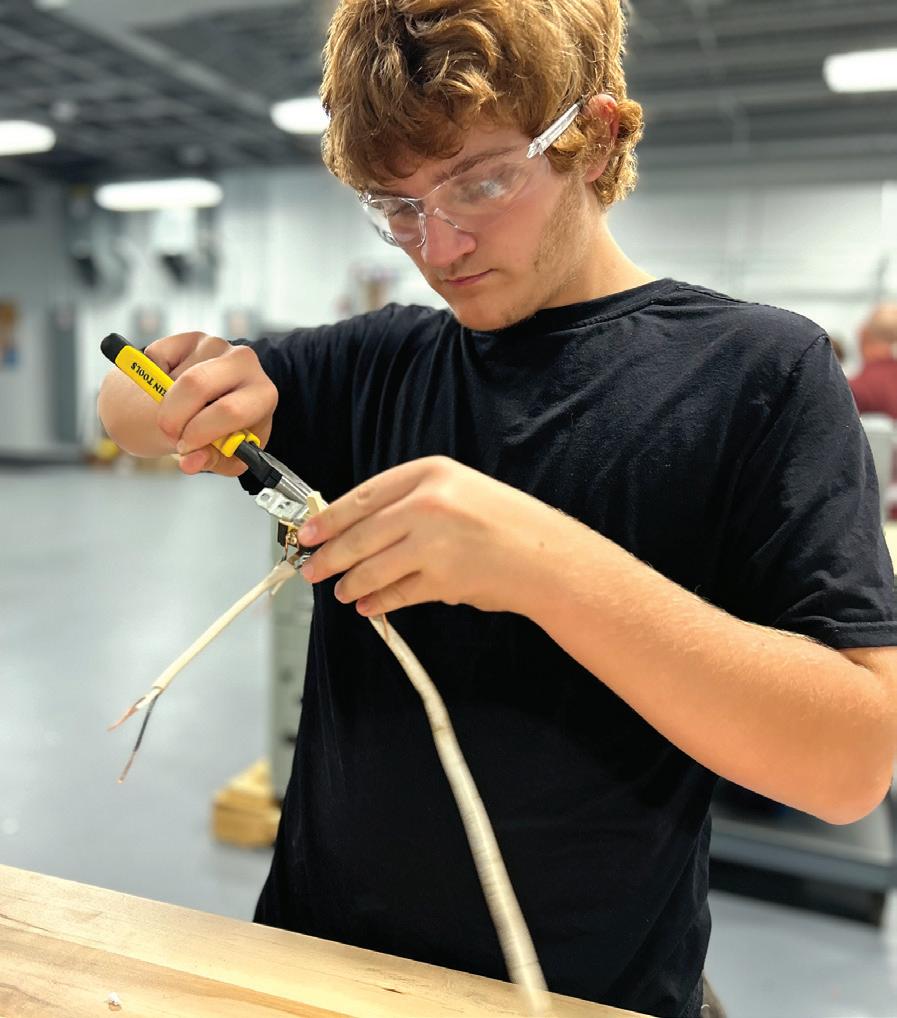WD building SKILL

With skilled workers in high demand, there’s no better time to pursue a career in the trades. Northeast Ohio is home to numerous associations, career centers, colleges and other organizations that can help you get started.




With skilled workers in high demand, there’s no better time to pursue a career in the trades. Northeast Ohio is home to numerous associations, career centers, colleges and other organizations that can help you get started.


CARPENTRY
Salary: $52,850 Average National Wage/ Estimated Growth: 8% by 2028
ELECTRICAL
Salary: $60,370 Average National Wage/ Estimated Growth: 10% by 2028
PLUMBING
Salary: $59,800 Average National Wage/ Estimated Growth: 14% by 2028
HVACR
Salary: $51,420 Average National Wage/ Estimated Growth: 13% by 2028
MASONRY
Salary: $56,470 Average National Wage/ Estimated Growth: 11% by 2028
PAINTING
Salary: $44,640 Average National Wage/ Estimated Growth: 6% by 2028
If you are interested in applying for a HBA scholarship, internship or to learn more about residential construction job opportunities, please contact the Home Builders Association (HBA) of Greater Cleveland at 216-447-8700.

Skilled trades offer personally and financially rewarding career pathways.
BY KRISTEN HAMPSHIRE
ruise by a lush landscape with an expansive outdoor kitchen designed to entertain. You helped build that. Lay the groundwork for a new addition that will provide a family with living space to gather and grow memories. You had a hand in making that dream come true. Preserve the environment by playing a role on the frontlines of keeping Lake Erie clean and healthy. Skilled trades professionals make all the difference.
The trades touch every aspect of our infrastructure and economy, from housing to transportation and beyond. These jobs are in demand, and they deliver immediate and rewarding career pathways.
In the construction industry alone, there’s a need for approximately 723,0000 new workers across the country to fill empty jobs, with “help wanted” openings averaging 300,000 to 400,000 every month, according to the latest Construction Labor Market Report from the Home Builders Institute (HBI), which provides an outlook for residential construction employment.
At least 90% of single-family builders responding to the survey reported a shortage of carpenters, and 80% to 85% cited a lack of subcontractors in six other key trades.
Pat Hurst is not at all surprised. “There’s a demand for every skilled trade,” says the owner of Hurst Design-Build-Remodel based in Westlake, who is also a member of NARI Cleveland, a trade association that represents remodeling professionals.
Hurst adds that the residential remodeling sector is booming. “It’s only going to continue,” he says.
Across the board, trades are working to create a ready pipeline of talent. Organizations like the Northeast Ohio Regional Sewer District offer tuition reimbursement, and

entry-level tradespeople are trained on the job while earning certifications at Cuyahoga Community College at no cost.
Last year, the Home Builders Association (HBA) of Greater Cleveland, in partnership with HBI, collaborated with Mayfield High School’s Administrator Deanne Elsing and Instructor Josh Hayes to launch a pilot PACT program, a blended learning program with a workforce development component that exposes students to the skilled trades. Six students participated who are now working in the field.
At a recent Mayfield High School open house, 32 students signed up for the program. PACT can provide high schools with a PreApprenticeship Certificate Training curricula and license.
Hayes says, “Kids want options, and as professionals in education, we have embraced
“ They’re seeing that a four-year college isn’t for everyone, and they can get out in the field, start working and build a great career.”
— Brenda Callaghan
opening up pathways to kids in other areas besides college. We can’t just continue to say the goal of high school is to get into college. That’s just not the case.”
HBA of Greater Cleveland has doubled down on workforce development initiatives through the PACT program and the support it can provide area schools that embrace skilled trades education. It’s a plug-andplay curriculum that’s built, recognized by the U.S. Department of Labor and ready to roll out. The program is based on the National Association of Home Builders’ Green Building Standards and National Skills Standards.
Across the country, HBI serves 15,000 students and supports their instructors.
The partnership at Mayfield has been a collaboration between school administration, instructors, the students and their parents and the HBA of Greater Cleveland.
HBA of Greater Cleveland Executive Director Brenda Callaghan is optimistic that the success of PACT at Mayfield High School will inspire other districts to deliver this already-proven opportunity to students.
“These students are coming out of PACT with the knowledge they need to gain em-
“The trades are really rewarding. You work with great people, and there’s an overall satisfaction of increasing your skills. You’re in demand and can work almost anywhere with your skill.”
— Pat Hurst
“The glamour in our industry is getting to work outdoors,” says Sandy Munley, executive director, Ohio Landscape Association (OLA). “You get to see those finished projects you created and watch landscapes grow, and they only get better with time.”
A range of careers in landscaping includes technicians and installation specialists who work with plant material, lighting, irrigation and hardscapes such as patios.
ployment,” Callaghan says, noting that students can jump into the program as seniors, unlike most traditional trades programs that require enrolling sophomore year. This allows for flexibility and also gives students nearing graduation a chance to explore skilled trades in an accessible way at their schools.
More students are open to the trades, Callaghan notices, pointing to Mayfield’s fivefold enrollment surge.
“They’re seeing that a four-year college isn’t for everyone, and they can get out in the field, start working and build a great career,” she says. “We are so excited about the program’s success and potential growth.”
Hurst is an example of someone who built a successful business in skilled trades


and now trains and offers career paths to other aspiring craftspeople.
“I wanted to be in the trades and love everything about it,” he says.
He notes that while most students in his high school were encouraged or pressured to attend a four-year college, he and his brother went their own way and never looked back.
“The trades are really rewarding. You work with great people, and there’s an overall satisfaction of increasing your skills,” he says. “You’re in demand and can work almost anywhere with your skill.”
And it’s a skill for life.
“That trade skill is not something anyone can take away from you,” Hurst says.
“One of the big services many landscape companies are adding is pool installation,” Munley notes. “This opens up a whole new ballgame of knowledge needed in the industry, and so many companies are happy to train people.”
And, those with a creative bent excel in landscape design using computer-aided design programs to create plans.
“Companies often employ shop mechanics to work on small engine equipment and trucks,” Munley adds.
OLA offers year-round courses in design, plant identification, plant health care, pruning, sales and more. Tri-C is home to one of the top two-year landscape and nursery programs in the country, Munley




RYAN WALLACE STARTED WITH HURST AS A CARPENTER’S APPRENTICE. TODAY HE PERFORMS ADVANCED CARPENTRY WORK AND OVERSEES THE DAY-TO-DAY ACTIVITIES ON HURST’S REMODELING PROJECTS.
points out. “We all work closely with Tri-C and offer scholarships for their program and other Ohio schools that teach horticulture,” she says.
At the Northeast Ohio Regional Sewer District (NEORSD), hands-on careers offer a give-back quality that appeals to many, says Jessica Shutty, community relations specialist.
“When we ask folks, ‘Why have you been here so long?’ so many people who are very environmentally conscious say they want to help out, and everything we do at the district somehow touches the environment,” she says. “At the end of the day, we are keeping Lake Erie clean, and that is rewarding.”
Operating a sewer district that serves 62 communities involves many moving parts.
“We have machines on site that require mechanics, and we maintain our everyday operations including landscaping and fleet services,” Shutty says.







NEORSD is hiring skilled trades such as plant maintenance electrician, industrial maintenance mechanic, instrument technician and systems utility maintenance specialist.
“When we bring folks in, we want them to stay,” Shutty says. “We work with our team members to create a job program where they get training, shadow folks in various departments and develop a career path.”
The possibility of pursuing a trade career is a discussion that should happen early on in education but can be revisited midcareer, too, with plenty of professionals who started in different fields deciding to change lanes. “We have lots of people in our industry who come to work for us who went to college, started in a career they thought they liked, like finance, and realized it wasn’t for them and their heart wasn’t in it,” Hurst relates. “They found their way to being a carpenter and realized they love it and can make a good living.”
Hurst says parents should encourage students to job shadow and try different classes, camps or experiences.
“The trades should be talked about openly, and they can lead to a very happy, fulfilling life,” he says.



An increasing number of women are pursuing in-demand careers in the skilled trades.
BY JILL SELL
he State of Ohio recently earmarked $100 million toward career technical education (CTE) equipment upgrades and another $200 million for the Career Technical Construction Program. However, women are still underrepresented in CTE, and particularly in the skilled trades that include the building industry.
Women represent only 4.3% of construction workers in the U.S. However, according to the Institute for Women’s Policy’s “Research on
Women Working in Construction” report, a record-breaking 363,651 women worked in the trades in 2023 — a 28% increase since 2018.
Along with expanded support from community leaders, educators and employers, it is the individuals in the trades today who are the best incentives for others to follow.
High school students are often encouraged to make decisions about a career in the trades as soon as possible, but Emma Varner, a member of International Brotherhood of Electrical Workers (IBEW Local 38) and cochair for Cleveland Tradeswomen, notes that “the trades are a good second chance.”
Varner holds a bachelor’s degree in film studies from Baldwin Wallace University. She worked for Screen Gems Studios in North Carolina for about four years as a member of the lighting and grip crews for television and movies. After moving back to Cleveland, Varner took an office job, which she says made her “miserable.”
“I knew I wanted to do something with my hands, and in 2018, I was accepted into a fiveyear apprenticeship, which I finished last summer,” says Varner, who was told on her first day

“not to fear electricity, but always respect it.” It wasn’t always easy, but Varner believes the support of her union brothers and sisters was vital.

“It’s also a career where you can plan your future and know you’ll have a good retirement.” — Emma Varner
“Going into the trades allows you to make a difference. I walk past the May Company building in Cleveland and I can’t stop telling my husband I worked there,” says Varner. “It’s also a career where you can plan your future and know you’ll have a good retirement.”
North Ridgeville resident Elizabeth (Lizzie) Rickard attended several school districts in Northeast Ohio, but it wasn’t until she enrolled in Lorain County JVS that her career path was sparked. There she was intrigued by the challenges and possibilities a career technical education could provide.
In 2022, Rickard graduated from Lorain County JVS’s industrial electricity program. That education taught her the basics of her chosen career and qualified her to begin working for an electrical contractor. She also completed OSHA safety training.
“In the summer between my junior and senior years, I got an internship with Jim’s Electric in North Ridgeville. Our teacher was really
good at making local connections for students,” says Rickard, who is currently employed by Zenith Systems, an electrical construction contractor in Cleveland. “I will be starting my five-year apprenticeship with Local 38 this fall, but I am going to be placed in my second year because of the experience I already have.”
That experience includes major construction projects such as working on the new $300 million, 36-story Sherwin-Williams Co. global headquarters in Downtown Cleveland. Like others in the trades who work on constructing or renovating some of the city’s most iconic buildings, she is proud to contribute to Cleveland’s skyline.
And, despite working in a male-dominated field, Rickard says it has been welcoming.
“When I worked at Jim’s Electric, I was the only girl. I was like everyone’s little sister or daughter. Now at Zenith, it is crazy to see how many women are actually in the field and that I work with,” says Rickard. “I am also surprised at how many journeymen are willing to take the time to teach me.”





Find out how local schools, financial assistance programs and scholarships are helping to make a career technical education attainable. BY JILL
The face of Cleveland is changing.
The new, $300 million, five-story Case Western Reserve University Interdisciplinary Science and Engineering building is expected to be completed in 2026. Major construction is underway at Cleveland Clinic’s Main Campus. And by the of start of the 2025 baseball season, the renovation of Progressive Field should be finished. Making all that possible — as well as hundreds of other, smaller building projects — are the electrical workers, plumbers, roofers, ironworkers, bricklayers, HVAC techs and others who work in what has been traditionally called the skilled trades.
Redefining
Recently, there has been a new push to expand and polish the reputation and respect for these workers through career technical education (CTE). This career path has been with us all the time, of course, but
SELL
perhaps underappreciated. Every public high school in Ohio is now required to offer CTE, whether on-site, at a regional joint vocational school or through another organization. CTE programs are available to both high school students and high school graduates and adult learners.
The Ohio Department of Education, Fordham Institute and other researchers have data that shows CTE students are more likely to graduate on time; more at-risk students are reached; certificates and occupational licenses can be earned; college credit can be earned; and strong community ties can be formed. Individuals who complete CTE also can generally receive high wages and good benefit packages. Graduates benefit from clear career paths and myriad job possibilities and locations.
Here’s a look at just some of the CTE opportunities available in Northeast Ohio:
Auburn Career Center in Concord Township offers comprehensive courses for high school students in construction, HVAC, architecture and project management, plant, turf and landscape management and more. Adult workforce education is also available.
Cuyahoga Valley Career Center students enrolled in the Construction Trades program will construct a modular house as they learn about building, remodeling, maintaining and repairing residential and commercial buildings. Training for certificates and licenses is available in HVAC, electrical, machine technology and fiber optics.
Lorain County JVS in Oberlin is one of the largest CTE schools in Ohio and draws from 13 school districts. The school is also well-known for its adult apprentice training in industrial maintenance, millwright, machine repair, sheet metal fabrication and more. It actively helps students seek financial assistance from Federal Pell Grants, OhioMeansJobs and veterans education benefits, as well as scholarships and employer-paid tuition sources.
Medina County Career Center assists students in applying for internships or co-ops in the summer with companies in manufacturing, construction, automotive and transportation. Apprenticeships in the skilled trades are an-
other pathway for students who are looking for cost-effective training with no debt.
Polaris Career Center uses an effective liaison approach to connect its 24 CTE programs to students in six school districts. Once enrolled, students are quickly exposed to real-world jobs. “It used to be the old days of vocational education that we wouldn’t get students out to the workplace until October of their senior year,” says Doug Miller, director of community outreach, adding that Polaris offers a construction and trades program and a building services tract, as well as ground maintenance and HVAC and refrigeration. “Now students are into internships between their junior and senior years.”

Cuyahoga Community College offers multiple pathways to lucrative careers. “Our workforce curriculum has really been a focus on providing the training that employers want,” says Jason Abbott, executive director of workforce operations for Tri-C. “A lot of that training is specific to the skilled trades with both our construction programs and our manufacturing programs.”
Tri-C’s pre-apprenticeship programs zero in on those two careers. The construction track is geared toward teaching students a basic knowledge of related subject areas (think carpentry, pipefitting, etc.) But the “overarching goal,” according to Abbott, is to connect students to appropriate apprenticeships.
“In manufacturing, we still teach a lot of basic things, because you will see companies that are still working with older equipment, but we also teach advanced systems. We want to make these students can walk into any manufacturing environment and feel as if they have been trained appropriately,” he says.
Pre-apprenticeship programs are of no cost to students in grades 7 through 12 because Tri-C utilizes College Credit Plus funding. In addition, Tri-C partners with the City of Cleveland’s Built Environment Initiative which provides pre-apprenticeship opportunities in construction for any Cleveland resident.
Lorain County Community College in Elyria offers certifications and workforce training in addition to bachelor’s and associate degrees. Focusing on regional workforce demands, the college points to more than 90% of its graduates finding “high-opportunity careers in Northeast Ohio.”
Apprenticeship programs are available in electrical, pipefitter, tool and die and more. Students enrolled in the school’s Earn and Learn program divide their time between classroom learning, paid jobs and internships. Among the formats available are: welding, micro electromechanical systems and CNC machining.

Explore every option to find your passion. Consider a career in a trade. Job security, excellent starting pay and a great career path.


